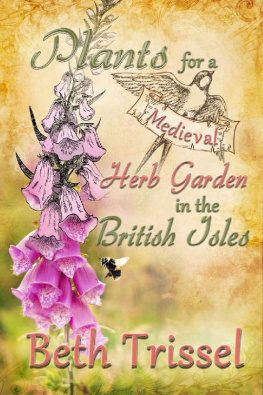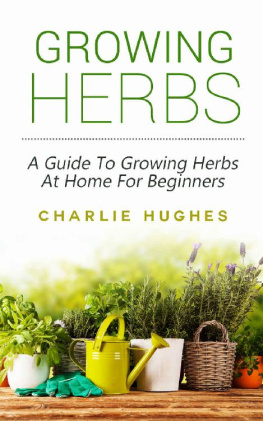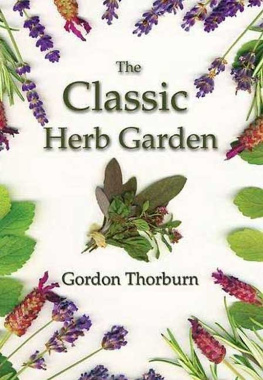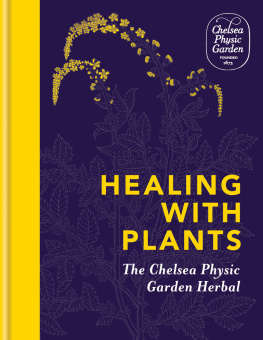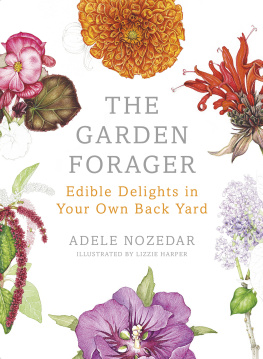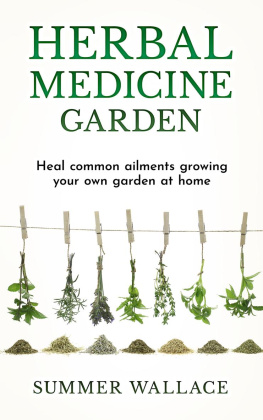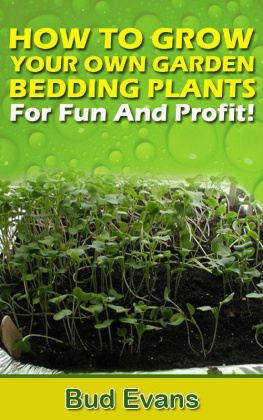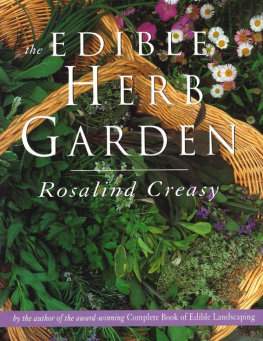As for the garden of mint, the very smell of it alone recovers and refreshes our spirits, as the taste stirs up our appetite for meat. ~ Pliny the Elder

Plants For A Medieval Herb Garden in the British Isles
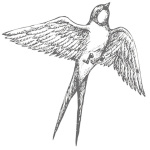
By Beth Trissel
Copyright February 2014 by Beth Trissel
This ebook is licensed for your personal enjoyment only. This ebook may not be re-sold or given away to other people. If you would like to share this book with another person, please purchase an additional copy for each recipient. Thank you for respecting the hard work of this author.
Cover by Elise Trissel
Contact:
Dedication:
For my dear Grandmother Mack, who helped instill in me a love of gardening and an appreciation for the names and properties of plants. I wish I knew half of what she did.
Introduction
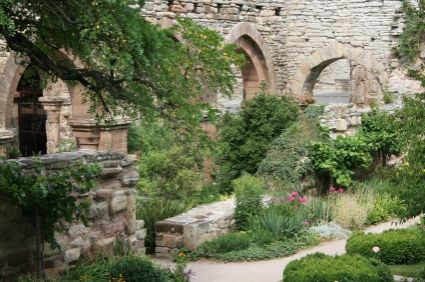
(Garden in Medieval Monastic Ruins)
The Middle Ages span a large chunk of time . In European history , the Medieval period lasted from the 5th to the 15th century and is subdivided into the Early, the High, and the Late Middle Ages. The plants grown in a Medieval herb or physic garden depended on time and place, as well as the availability of the plants. The Crusades played a vital role in the introduction of new varieties. Some of the herbs we consider inherently English, notably, rosemary, sage, and thyme, were introduced to Britain with the return of the Crusaders (the 11 th through the 13 th century). Before the Crusades, fewer plants were available for an herb garden. Lavender, such a favorite, didnt arrive on the scene in England before the mid-16 th century.
Spices, so common today but rare then, also made their first appearance with the Crusaders. Among these were nutmeg, ginger, and peppercorns, only afforded by the wealthy. Medieval England was mad for these new taste sensations that added zest to their food and helped disguise spoiled meat. Nutmeg was touted as a cure for the plague. Ginger also made that claim, and peppercorns were worth their weight in gold. Wars were fought over spices, but back to the plants. U nless an individual lived in an isolated region and gleaned only native species, a Medieval physic garden would have had many varieties. The herbs werent grown for their beauty alone, so much as for their healing properties. To the modern eye, they might appear rather weedy. Plants were peoples medicine kits, and aesthetics wasnt the focus. These were not the opulent luxury gardens, but humble and earthy.
Not all of these herbs grow year round in winter, so root stock, cuttings, or seed would have been saved for the next season. Depending on what part of the plant was desired, the leaves, roots, bark, seeds, fruit, etc, determined whether they were used fresh or preserved. Methods of preparation include: waters (simple or distilled), infusions, decoctions, cordials, syrups, conserves, tinctures, oils Simples are the use of one herb, rather than a combination.
th century botanist and apothecary Sir John Hill in his book, The Family Herbal , says, In general, leaves, flowers, and entire plants whether fresh or dried, are used in infusions; the roots and bark in decoctions. So decoctions are for the tougher materials. When fresh roots are used, he advises first cutting them into thin slices. Fresh bark should be shaved down to better prepare it. Grind dried roots into a coarse powder before using them in a decoction.
A decoction might be infused with nut oil, wine, vinegar, alcohol, or water and then dispensed by the spoonful or wineglassful in the proportions deemed appropriate. This was guesswork. Tinctures are concentrated and dispensed by drops. Only a skilled herbalist was able to more accurately judge how much was enough. In the case of potentially poisonous herbs, too much was lethal. And still is. Dosage is critical.
Herbs were dispensed singly or as a mixture. If an external dressing was needed, a poultice or compress might be applied. Herbal ointments were commonly made with lard. The wealthy might employ more exotic ingredients such as nut oil, wax, and resin. Medicinal baths were also used, or the patient breathed in the vapors of a steeping herb or the smoke from burning leaves. How the curative powers were delivered depended on the plant and the ailment or injury being treated.
Ive compiled a list of many herbs, including some trees, that could have been grown in an English Medieval Herb Garden after the Crusades. These have been noted, also whether the plants were indigenous, and, if not, when they arrived in England. Many would have been cultivated in other regions of the British Isles, Scotland, Ireland, and Wales, depending on climate conditions and access to seeds. Where possible, I noted that too, particularly Scotland. Medical properties and uses are given after each one. Ive listed the plants in alphabetical order. Or tried. The complete plant index is at the end of this work. Some plants make appearances in reference to others because herbs are often used in combinations in medical applications. And, depending on the full name, they may not appear in the order you expect.
***Disclaimer: I am not advocating the medicinal use of these plants, only providing information about their age-old uses. Any applications are strictly up to you. Added cautions are provided for potentially poisonous herbs. Heed them.
Much of the information provided is from A Modern Herbal by Margaret Grieve. If you wonder at the spelling, its British and Old English. A Modern Herbal is a wonderful source of herbal lore as well as information on the medicinal uses and growing requirements for a myriad of plants, an invaluable guide. I have volumes one and two of Ms. Grieves work and can easily lose myself in their pages, and have. She refers to her herbal as modern, and in comparison to the ancient herbalists it is, but A Modern Herbal is charmingly quaint and published in the early 20 th century. Bear that in mind. Opiates were still perfectly legal then. Just because she tells you how to brew up various concoctions, doesnt mean you still can from a legal viewpoint, or that you should from a medicinal one. I also included some references from Rodales Illustrated Encyclopedia of Herbs, The Scots Herbal by Tess Darwin, and The Family Herbal, an enjoyable and informative herbal by 18 th century botanist and apothecary Sir John Hill. I highly recommend all these books. A few fascinating websites are also referenced and links provided.
Also important to remember regarding this time period: Monks were vital in preserving the rudiments of civilization during the Dark Ages. Along with the laborious hand copying of books and the holy scriptures, these devout men stored up a wealth of herbal knowledge. They grew numerous plants in their physic gardens, assuring the survival of the herbs and an understanding of their medicinal values, doctored the sick in monastic hospitals, and ministered to the poor. And far more. Physic gardens were also kept by Medieval apothecaries whose apprentices received hands-on training in plant identification, uses, and dosage.
In the intriguing British television series, Cadfael , based on the novels by Ellis Peters, Brother Cadfael, a former Crusader who killed a lot of men, is atoning for his sins by being a healer and bringing about justice in Medieval England. With his cunning and knowledge of herbs, he solves murders. This series is a win, win for any history, mystery, and herbal lover.
Next page
